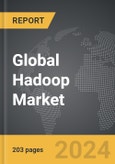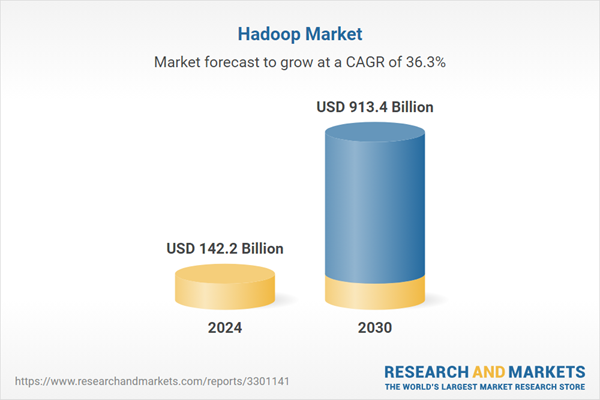The global market for Hadoop was valued at US$142.2 Billion in 2024 and is projected to reach US$913.4 Billion by 2030, growing at a CAGR of 36.3% from 2024 to 2030. This comprehensive report provides an in-depth analysis of market trends, drivers, and forecasts, helping you make informed business decisions. The report includes the most recent global tariff developments and how they impact the Hadoop market.
One of Hadoop's most significant strengths is its ability to handle vast quantities of data, whether structured, semi-structured, or unstructured. This flexibility allows organizations to adapt quickly without the need for extensive pre-processing, making Hadoop suitable for diverse data types and formats, including text, images, and videos. Hadoop's scalability is another key feature; it can easily expand by adding nodes, minimizing administrative overhead. This design ensures that data processing remains resilient and reliable, even in the event of node failures. Additionally, Hadoop's open-source nature significantly reduces the costs associated with big data management, particularly for storing large data volumes. Major tech companies like Facebook and Amazon utilize Hadoop to manage and analyze their vast data sets, showcasing the framework's versatility across various industries.
Several factors drive the growth of Hadoop adoption. Technological advancements in storage and computing power have made managing larger datasets more feasible and cost-effective. The surge in data generation from IoT devices necessitates robust data processing and analytics capabilities, which Hadoop provides. The increasing demand for real-time data processing and analytics is met by integrating tools like Apache Kafka and Apache Storm into the Hadoop ecosystem. The proliferation of machine learning and AI applications further drives the need for platforms like Hadoop that can support the extensive data infrastructure required for these technologies. Compliance with data protection regulations, advancements in data formats, and the shift towards cloud computing also contribute to Hadoop's growth. As organizations seek to provide personalized customer experiences and leverage cloud environments, Hadoop's capabilities become even more critical, ensuring its continued relevance in managing modern data-driven environments.
Segments: Component (Services, Software, Hardware); End-Use (Retail, Government, BFSI, IT & ITES, Healthcare, Telecommunications, Other End-Uses).
Geographic Regions/Countries: World; United States; Canada; Japan; China; Europe (France; Germany; Italy; United Kingdom; and Rest of Europe); Asia-Pacific; Rest of World.
The analysts continuously track trade developments worldwide, drawing insights from leading global economists and over 200 industry and policy institutions, including think tanks, trade organizations, and national economic advisory bodies. This intelligence is integrated into forecasting models to provide timely, data-driven analysis of emerging risks and opportunities.
Global Hadoop Market - Key Trends and Drivers Summarized
Hadoop is a pivotal framework in the realm of big data, offering robust storage and efficient processing capabilities across distributed computer clusters. As data generation continues to escalate - especially from social media and the Internet of Things (IoT) - Hadoop's relevance grows, serving as a critical tool for businesses to manage vast amounts of data with agility and precision. Initially developed to address the challenges of indexing and searching large web data sets, Hadoop has evolved significantly since its inception. Doug Cutting and Mike Cafarella's project, Nutch, laid the foundation for Hadoop, which was later refined and expanded at Yahoo. By 2008, Hadoop had become an open-source project managed by the Apache Software Foundation, fostering a global community of developers. Its core components, including the Hadoop Distributed File System (HDFS), YARN, MapReduce, and newer additions like Hadoop Ozone and Submarine, are essential for distributed data storage, resource management, and parallel processing.One of Hadoop's most significant strengths is its ability to handle vast quantities of data, whether structured, semi-structured, or unstructured. This flexibility allows organizations to adapt quickly without the need for extensive pre-processing, making Hadoop suitable for diverse data types and formats, including text, images, and videos. Hadoop's scalability is another key feature; it can easily expand by adding nodes, minimizing administrative overhead. This design ensures that data processing remains resilient and reliable, even in the event of node failures. Additionally, Hadoop's open-source nature significantly reduces the costs associated with big data management, particularly for storing large data volumes. Major tech companies like Facebook and Amazon utilize Hadoop to manage and analyze their vast data sets, showcasing the framework's versatility across various industries.
Several factors drive the growth of Hadoop adoption. Technological advancements in storage and computing power have made managing larger datasets more feasible and cost-effective. The surge in data generation from IoT devices necessitates robust data processing and analytics capabilities, which Hadoop provides. The increasing demand for real-time data processing and analytics is met by integrating tools like Apache Kafka and Apache Storm into the Hadoop ecosystem. The proliferation of machine learning and AI applications further drives the need for platforms like Hadoop that can support the extensive data infrastructure required for these technologies. Compliance with data protection regulations, advancements in data formats, and the shift towards cloud computing also contribute to Hadoop's growth. As organizations seek to provide personalized customer experiences and leverage cloud environments, Hadoop's capabilities become even more critical, ensuring its continued relevance in managing modern data-driven environments.
Report Scope
The report analyzes the Hadoop market, presented in terms of units. The analysis covers the key segments and geographic regions outlined below.Segments: Component (Services, Software, Hardware); End-Use (Retail, Government, BFSI, IT & ITES, Healthcare, Telecommunications, Other End-Uses).
Geographic Regions/Countries: World; United States; Canada; Japan; China; Europe (France; Germany; Italy; United Kingdom; and Rest of Europe); Asia-Pacific; Rest of World.
Key Insights:
- Market Growth: Understand the significant growth trajectory of the Services segment, which is expected to reach US$472.0 Billion by 2030 with a CAGR of a 38.1%. The Software segment is also set to grow at 36.2% CAGR over the analysis period.
- Regional Analysis: Gain insights into the U.S. market, valued at $38.5 Billion in 2024, and China, forecasted to grow at an impressive 34.4% CAGR to reach $134.1 Billion by 2030. Discover growth trends in other key regions, including Japan, Canada, Germany, and the Asia-Pacific.
Why You Should Buy This Report:
- Detailed Market Analysis: Access a thorough analysis of the Global Hadoop Market, covering all major geographic regions and market segments.
- Competitive Insights: Get an overview of the competitive landscape, including the market presence of major players across different geographies.
- Future Trends and Drivers: Understand the key trends and drivers shaping the future of the Global Hadoop Market.
- Actionable Insights: Benefit from actionable insights that can help you identify new revenue opportunities and make strategic business decisions.
Key Questions Answered:
- How is the Global Hadoop Market expected to evolve by 2030?
- What are the main drivers and restraints affecting the market?
- Which market segments will grow the most over the forecast period?
- How will market shares for different regions and segments change by 2030?
- Who are the leading players in the market, and what are their prospects?
Report Features:
- Comprehensive Market Data: Independent analysis of annual sales and market forecasts in US$ Million from 2024 to 2030.
- In-Depth Regional Analysis: Detailed insights into key markets, including the U.S., China, Japan, Canada, Europe, Asia-Pacific, Latin America, Middle East, and Africa.
- Company Profiles: Coverage of players such as Amazon Web Services, Inc., Cisco Systems, Inc., Cloudera, Inc., Datameer, Inc., FICO (Fair Isaac Corporation) and more.
- Complimentary Updates: Receive free report updates for one year to keep you informed of the latest market developments.
Some of the 111 companies featured in this Hadoop market report include:
- Amazon Web Services, Inc.
- Cisco Systems, Inc.
- Cloudera, Inc.
- Datameer, Inc.
- FICO (Fair Isaac Corporation)
- Hitachi Vantara Corporation
- Hortonworks, Inc.
- MapR Technologies, Inc.
- MarkLogic Corporation
- Teradata Corporation
Tariff Impact Analysis: Key Insights for 2025
Global tariff negotiations across 180+ countries are reshaping supply chains, costs, and competitiveness. This report reflects the latest developments as of April 2025 and incorporates forward-looking insights into the market outlook.The analysts continuously track trade developments worldwide, drawing insights from leading global economists and over 200 industry and policy institutions, including think tanks, trade organizations, and national economic advisory bodies. This intelligence is integrated into forecasting models to provide timely, data-driven analysis of emerging risks and opportunities.
What’s Included in This Edition:
- Tariff-adjusted market forecasts by region and segment
- Analysis of cost and supply chain implications by sourcing and trade exposure
- Strategic insights into geographic shifts
Buyers receive a free July 2025 update with:
- Finalized tariff impacts and new trade agreement effects
- Updated projections reflecting global sourcing and cost shifts
- Expanded country-specific coverage across the industry
Table of Contents
I. METHODOLOGYII. EXECUTIVE SUMMARY2. FOCUS ON SELECT PLAYERSIII. MARKET ANALYSISIV. COMPETITION
1. MARKET OVERVIEW
3. MARKET TRENDS & DRIVERS
4. GLOBAL MARKET PERSPECTIVE
UNITED STATES
CANADA
JAPAN
CHINA
EUROPE
FRANCE
GERMANY
ITALY
UNITED KINGDOM
REST OF EUROPE
ASIA-PACIFIC
REST OF WORLD
Companies Mentioned (Partial List)
A selection of companies mentioned in this report includes, but is not limited to:
- Amazon Web Services, Inc.
- Cisco Systems, Inc.
- Cloudera, Inc.
- Datameer, Inc.
- FICO (Fair Isaac Corporation)
- Hitachi Vantara Corporation
- Hortonworks, Inc.
- MapR Technologies, Inc.
- MarkLogic Corporation
- Teradata Corporation
Table Information
| Report Attribute | Details |
|---|---|
| No. of Pages | 203 |
| Published | April 2025 |
| Forecast Period | 2024 - 2030 |
| Estimated Market Value ( USD | $ 142.2 Billion |
| Forecasted Market Value ( USD | $ 913.4 Billion |
| Compound Annual Growth Rate | 36.3% |
| Regions Covered | Global |









